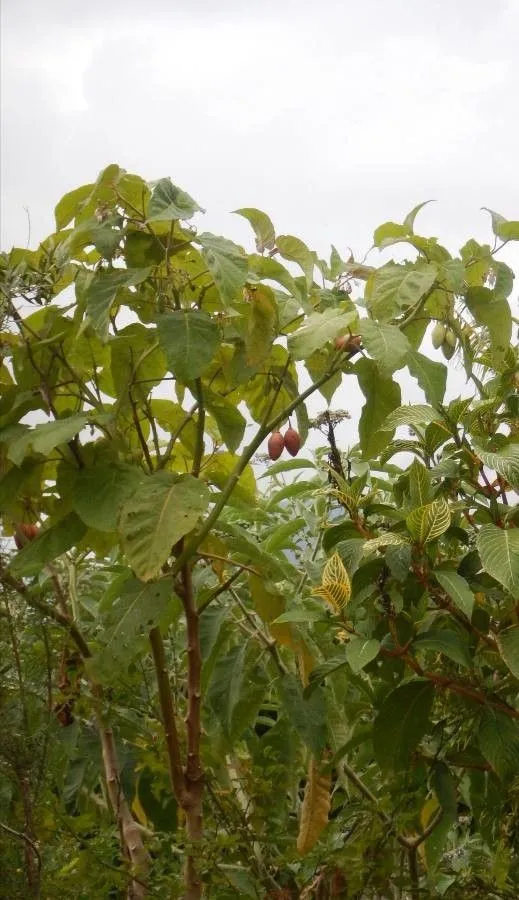
Author: Cav.
Bibliography: Anales Hist. Nat. 1:44. 1799
Year: 1799
Status: accepted
Rank: species
Genus: Solanum
Vegetable: False
Observations: S. Trop. America
The Tree-tomato, scientifically known as Solanum betaceum, is a vibrant and intriguing plant that belongs to the Solanaceae family. This unique species was first documented in 1799 in an article by the esteemed botanist Cav., published in “Anales Hist. Nat.”.
Originally hailing from the lush and diverse regions of South Tropical America, the tree-tomato has carved out a niche for itself both in native habitats and cultivated gardens worldwide due to its distinctive fruit and aesthetic appeal. The plant is admired for its small tree or bush-like structure, which can reach up to 10 feet in height, and its striking, heart-shaped leaves that lend a tropical appearance to any landscape.
One of the most captivating features of the tree-tomato is its fruit, which dangles from the branches like colorful ornaments. These oval-shaped fruits come in a variety of hues, including red, orange, yellow, and even purple, with some varieties boasting bi-colored skins. Not only are they visually appealing, but they are also packed with nutritional value. Rich in vitamins A, C, and E, as well as antioxidants, the tree-tomato fruit is a powerhouse of health benefits.
In terms of flavor, the tree-tomato fruit offers a unique blend that is often described as a cross between a tomato and a passion fruit, with a tangy yet slightly sweet profile. This versatility makes it an excellent ingredient for both sweet and savory dishes. It can be eaten raw, scooped out with a spoon, or used to add a splash of color and zest to salads, sauces, chutneys, and desserts.
Cultivating the tree-tomato is relatively straightforward, making it an accessible option for home gardeners and commercial growers alike. It thrives in well-drained soils and prefers a temperate climate, though it can tolerate a range of conditions given proper care. Regular pruning helps maintain its shape and encourages a better yield of fruit.
Ecologically, the tree-tomato plays a valuable role in its native habitat, attracting various pollinators with its fragrant flowers that bloom year-round. The fruit also serves as a food source for several bird and insect species, highlighting its importance in the ecosystem.
In traditional medicine, the tree-tomato has been valued for its health-promoting properties. Indigenous communities have used various parts of the plant to treat ailments such as respiratory issues, digestive discomforts, and skin conditions, reflecting its cultural significance and medicinal versatility.
Overall, the tree-tomato is a testament to the incredible biodiversity of South Tropical America and the culinary and ecological richness it offers. Its vibrant fruit, nutritional benefits, and ease of cultivation make it a cherished plant for gardeners, chefs, and nature enthusiasts around the world.
Deu: baumtomate
Fra: arbre à tomates, tomate de la paz, tomate en arbre
Spa: tamarillo, tomate de árbol, tomate serrano, lima tomate, tomate extranjero, tomato de arbol
Por: tomate-de-árvore
Eng: tree-tomato, tamarillo, tree tomato
Swe: trädtomat
En: Tree-tomato, Tamarillo, Tree tomato
Am: ኣምባሩድ
Ar: طماطم شجري
Eu: Tamarilo
Ca: Tomàquet d’arbre
Zh: 树西红柿
Cs: Rajčenka
Nl: Tamarillo
Fi: Puutomaatti
Fr: Tomate de La Paz, Tomate en arbre, Arbre à tomates, Tamarillo, Tomate arbuste
Gl: Tomate de árbore
De: Baumtomate, Tamarillo
Ht: Tamariyo
Id: Terung belanda
It: Cyphomandra betacea
Jv: Térong walanda
Rw: Ikinyomoro
Kv: Тамарилло
Lg: Omunyanya
Ms: Pokok Terung Belanda
Ml: മരത്തക്കാളി
Fa: تاماریلو
Pl: Cyfomandra grubolistna
Pt: Tomate-de-árvore, Tomate arbóreo, Tamarilho
Pt-br: Tomate-francês, Tomateiro-arbusto
Qu: Yunka ch’illtu
Ru: Тамарилло
Sr: Tamarilo
Sk: Rajčiakovec repový
Es: Tamarillo, Tomate de árbol, Tomate serrano, Lima Tomate, Tomate Extranjero, Tomato De Arbol
Sv: Trädtomat, Tamarillo
Ta: மரத் தக்காளி
Th: มะเขือเทศต้น
Tr: Tamarillo
Uk: Тамарільйо
Taken Nov 2, 2018 by Émile Maurice (cc-by-sa)
Taken Apr 9, 2017 by Hugo SANTACREU (cc-by-sa)
Taken Jan 16, 2021 by Diego Alex (cc-by-sa)
Taken Sep 8, 2020 by Jean-Marc Vessot (cc-by-sa)
Taken Jun 8, 2015 by Tela Botanica − Hugo SANTACREU (cc-by-sa)
Taken Mar 7, 2016 by Hugo SANTACREU (cc-by-sa)
Taken Nov 2, 2018 by Émile Maurice (cc-by-sa)
Taken Jan 28, 2022 by Shehadi Ramiz (cc-by-sa)
Taken Oct 22, 2017 by Hugo SANTACREU (cc-by-sa)
Taken Apr 7, 2019 by Jérôme robert (cc-by-sa)
Taken Jun 24, 2015 by Tela Botanica − Anziz AHMED ABDOU (cc-by-sa)
Taken Nov 13, 2020 by Juansae Morales Xuacha (cc-by-sa)
Taken Mar 7, 2016 by Hugo SANTACREU (cc-by-sa)
Taken Jan 28, 2022 by Shehadi Ramiz (cc-by-sa)
Taken Apr 2, 2021 by chaen (cc-by-sa)
© copyright of the Board of Trustees of the Royal Botanic Gardens, Kew.
© copyright of the Board of Trustees of the Royal Botanic Gardens, Kew.
© copyright of the Board of Trustees of the Royal Botanic Gardens, Kew.
Taken Oct 22, 2017 by Hugo SANTACREU (cc-by-sa)
Taken Apr 1, 2019 by Radins José (cc-by-sa)
Taken Dec 10, 2021 by Oleev Torrin (cc-by-sa)
Taken May 5, 2019 by heinz-dieter Stolpe (cc-by-sa)
Taken Apr 7, 2019 by Jérôme robert (cc-by-sa)
Taken Nov 17, 2014 by Tela Botanica − Liliane Roubaudi (cc-by-sa)
Taken Nov 17, 2014 by Tela Botanica − Liliane Roubaudi (cc-by-sa)
Taken Mar 27, 2022 by Busch Ana (cc-by-sa)
Taken Oct 22, 2017 by Hugo SANTACREU (cc-by-sa)
Taken Dec 4, 2021 by Busch Ana (cc-by-sa)
Taken Sep 27, 2020 by Gonçalves Teresa (cc-by-sa)
Taken Sep 10, 2020 by codecas (cc-by-sa)
Taken Nov 17, 2014 by Tela Botanica − Liliane Roubaudi (cc-by-sa)
Taken Dec 21, 2011 by Tela Botanica − Yoan MARTIN (cc-by-sa)
Family: Myrtaceae Author: (F.Muell.) K.D.Hill & L.A.S.Johnson Bibliography: Telopea 6: 402 (1995) Year: 1995 Status:…
Family: Rubiaceae Author: Pierre ex A.Froehner Bibliography: Notizbl. Bot. Gart. Berlin-Dahlem 1: 237 (1897) Year:…
Family: Sapindaceae Author: Koidz. Bibliography: J. Coll. Sci. Imp. Univ. Tokyo 32(1): 38 (1911) Year:…
Family: Asteraceae Author: A.Gray Bibliography: Pacif. Railr. Rep.: 107 (1857) Year: 1857 Status: accepted Rank:…
Family: Fabaceae Author: Medik. Bibliography: Vorles. Churpfälz. Phys.-Ökon. Ges. 2: 398 (1787) Year: 1787 Status:…
Family: Aspleniaceae Author: (Cav.) Alston Bibliography: Bull. Misc. Inform. Kew 1932: 309 (1932) Year: 1932…